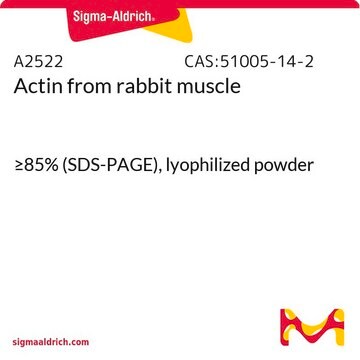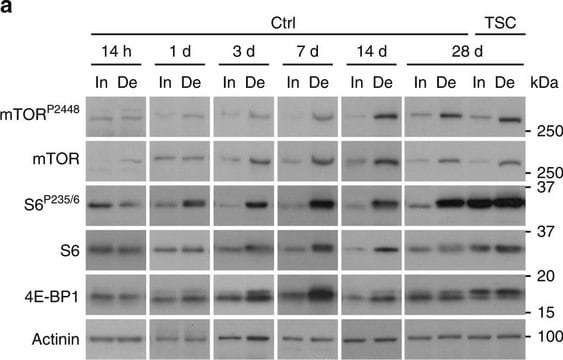A9776
α-Actinin from chicken gizzard
~80% α-actinin basis (SDS-PAGE), ammonium sulfate suspension
Sign Into View Organizational & Contract Pricing
All Photos(1)
About This Item
Recommended Products
biological source
chicken gizzard
Assay
~80% α-actinin basis (SDS-PAGE)
form
ammonium sulfate suspension
mol wt
100 kDa
storage temp.
2-8°C
Gene Information
chicken ... ACTN2(396263) , ACTN4(396024) , RCJMB04_23c5(373918)
human ... ACTN1(87)
mouse ... ACTN1(109711)
rat ... ACTN1(81634)
General description
α-Actinin exists as a rod-shaped antiparallel dimer with two elongated subunits. The domain region contains an N-terminal actin-binding domain with tandem calponin homology domains, a central tandem 3-helix motifs, and EF-hand motifs at C-terminus. It belongs to the spectrin superfamily and is localized in actin structures.
Application
α-Actinin from chicken gizzard has been used:
- as an antigen to coat plates for the capture of anti-actinin antibody using enzyme-linked immunosorbent assay (ELISA) from tumor cell line clones
- in in vitro motility experiments to test its effect on actin filament movement
- to coat cantilevers for strengthening fluorescently labeled actin filaments in force measurement studies
Biochem/physiol Actions
α-Actinin binds actin and has the ability to crosslink actin cytoskeleton. It also plays a key role in the structural maintenance of the Z-disk of striated muscle.
Packaging
Package size based on protein content
Physical form
Suspension in 2 M (NH4)2SO4 containing 20 mM Tris acetate, pH 7.6, 20 mM sodium chloride, 0.1 mM EDTA, 15 mM β-mercaptoethanol and 1 mM phenylmethylsulfonyl fluoride
Preparation Note
Alpha-actinin ammonium sulfate suspension should be mixed sufficiently and further diluted prior to use. Protein precipitate will be present in solution with high protein concentrations.
Prepared using a modification of the procedure of Neidel, J.E. and Cuatrecasas, P., Biochem. Biophys. Res. Commun., 91, 152 (1979).
Prepared using a modification of the procedure of Neidel, J.E. and Cuatrecasas, P., Biochem. Biophys. Res. Commun., 91, 152 (1979).
Storage Class Code
10 - Combustible liquids
WGK
WGK 3
Flash Point(F)
Not applicable
Flash Point(C)
Not applicable
Personal Protective Equipment
dust mask type N95 (US), Eyeshields, Gloves
Choose from one of the most recent versions:
Already Own This Product?
Find documentation for the products that you have recently purchased in the Document Library.
F Rivero et al.
Journal of cell science, 112 ( Pt 16), 2737-2751 (1999-07-22)
The contribution of three actin cross-linking proteins, alpha-actinin (alphaA), gelation factor (ABP-120), and the 34 kDa actin-bundling protein to cellular functions has been studied in three single mutant (alphaA-, 120-, and 34-) and three double mutant (alphaA-/120-, 34-/alphaA-, 34-/120-) strains
Anja Katzemich et al.
PLoS genetics, 9(3), e1003342-e1003342 (2013-03-19)
The Drosophila Alp/Enigma family protein Zasp52 localizes to myotendinous junctions and Z-discs. It is required for terminal muscle differentiation and muscle attachment. Its vertebrate ortholog ZASP/Cypher also localizes to Z-discs, interacts with α-actinin through its PDZ domain, and is involved
Jun Liu et al.
Journal of molecular biology, 338(1), 115-125 (2004-03-31)
Cryoelectron microscopy was used to obtain a 3-D image at 2.0 nm resolution of 2-D arrays of smooth muscle alpha-actinin. The reconstruction reveals a well-resolved long central domain with 90 degrees of left-handed twist and near 2-fold symmetry. However, the
Timothy Travers et al.
Biophysical journal, 104(3), 705-715 (2013-02-28)
The assembly of proteins into multidomain complexes is critical for their function. In eukaryotic nonmuscle cells, regulation of the homodimeric actin cross-linking protein α-actinin-4 (ACTN4) during cell migration involves signaling receptors with intrinsic tyrosine kinase activity, yet the underlying molecular
Nicola Cacciani et al.
Acta physiologica (Oxford, England), 229(1), e13425-e13425 (2019-12-05)
Critical illness myopathy (CIM) represents a common consequence of modern intensive care, negatively impacting patient health and significantly increasing health care costs; however, there is no treatment available apart from symptomatic and supportive interventions. The chaperone co-inducer BGP-15 has previously
Our team of scientists has experience in all areas of research including Life Science, Material Science, Chemical Synthesis, Chromatography, Analytical and many others.
Contact Technical Service







